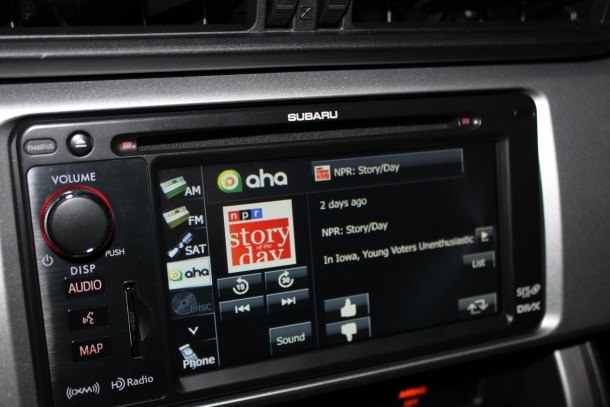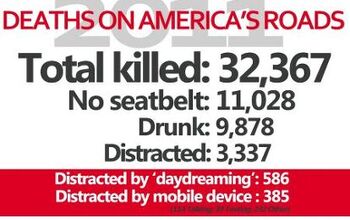Will NHTSA's Distracted Driving Guidelines Cripple Navigation Displays?

Last month the Dept. of Transportation, through NHTSA, issued proposed guidelines on drivers’ use of electronic devices that could distract them from driving. Wayne Cunningham, an automotive writer for CNet, has been mining the 177 page document and he’s uncovered regulations that would effectively cripple navigation systems as we know them and also reduce the amount of information a car’s systems can display to a driver at any one time.
Section V.5 of the Visual-Manual NHTSA Driver Distraction Guidelines for In-Vehicle Electronic Devices is devoted to graphical displays, including photographs and video, and NHTSA frowns on what they call “dynamic” displays. The guidelines call for static or “near-static” displays. Near-static would conform to NHTSA’s intention of prohibiting any act that would take up more than 2 continuous seconds of a driver’s attention. Obviously a static map on a navigation system would be of little practical value, compared to how drivers use today’s nav systems. A “near-static” display that updates in 2 second increments would be of little value at intersections and changes in direction. Lest you think this is an alarmist reading of a harmless regulation, the guidelines are very clear that their intent is to cripple dynamic navigation systems that show your car’s position on a moving map, or alternatively, a moving car on a fixed map.
V.5.b Dynamic map displays. The display of either static or quasi-static maps (quasi-static maps are static maps that are updated frequently, perhaps as often as every few seconds, but are not continuously moving) for the purpose of providing driving directions is acceptable. Dynamic, continuously-moving maps are not recommended. (emphasis added)
At 30 MPH you’re traveling 44 feet per second. A navigation system that only updates every 2 seconds would be functionally useless in most driving situations. You’d be past your turns and destination before the system could update itself. None of these guidelines, by the way, were arrived at after actually measuring how using navigation systems could possibly distract drivers. Instead they are based on the agency’s general testing that shows that tasks requiring 2 seconds of continuous attention are distracting, as are discontinuous tasks that in total take up 12 seconds or more of your attention.
A system that does not update continuously would be more distracting because drivers would spend more time looking at the nav screen. When a display changes continuously, there’s less need to check it frequently.
Another guideline Cunningham discovered that could change the way cars work is how text can be displayed as well as entered.
V.5.g Reading more than 30 characters (not counting punctuation marks, counting each number, no matter how many digits it contains, as one character, and counting units such as mph as just one character) of visually presented text.
Way more than 30 characters.
Cunningham points out that a standard satellite radio display of a station, show and song title can easily exceed 30 characters. The guidelines also prohibit the use of scrolling text – that would be too dynamic.
V.5.e Automatically scrolling text. The display of continuously moving text is not recommended. The visual presentation of limited amounts of static or quasi-static text is acceptable.
You also wouldn’t be able to enter an address into your nav system while driving, unless the address is fewer than six characters total.
V.5.f Manual text entry. A driver should not enter more than six button or key presses during a single task. This would include drafting text messages and keyboard-based text entry.
It seems to me that another of the guidelines, one concerning obstructed vision, might prohibit heads-up displays.
V.1 No Obstruction of View.
V.1.a No part of the physical device should, when mounted in the manner intended by the manufacturer, obstruct a driver’s field of view.
I’m not sure if the HUD qualifies as a “physical device”. It does incorporate a plastic film in the windshield made by DuPont. Though the HUD doesn’t obstruct the driver’s view in any manner that would affect safety, it does, technically, obstruct the driver’s field of view, and if enacted those guidelines will be the law.
These guidelines are meant to address changing in-car “infotainment” technologies. Come to think of it, the guideline about not pressing more than six buttons during a single task makes me think that this would regulate perhaps the oldest of infotainment technologies, the pushbutton radio.
There are more than six buttons on that electronic device. Quick, call DOT!

Ronnie Schreiber edits Cars In Depth, the original 3D car site.
More by Ronnie Schreiber
Latest Car Reviews
Read moreLatest Product Reviews
Read moreRecent Comments
- ToolGuy First picture: I realize that opinions vary on the height of modern trucks, but that entry door on the building is 80 inches tall and hits just below the headlights. Does anyone really believe this is reasonable?Second picture: I do not believe that is a good parking spot to be able to access the bed storage. More specifically, how do you plan to unload topsoil with the truck parked like that? Maybe you kids are taller than me.
- ToolGuy The other day I attempted to check the engine oil in one of my old embarrassing vehicles and I guess the red shop towel I used wasn't genuine Snap-on (lots of counterfeits floating around) plus my driveway isn't completely level and long story short, the engine seized 3 minutes later.No more used cars for me, and nothing but dealer service from here on in (the journalists were right).
- Doughboy Wow, Merc knocks it out of the park with their naming convention… again. /s
- Doughboy I’ve seen car bras before, but never car beards. ZZ Top would be proud.
- Bkojote Allright, actual person who knows trucks here, the article gets it a bit wrong.First off, the Maverick is not at all comparable to a Tacoma just because they're both Hybrids. Or lemme be blunt, the butch-est non-hybrid Maverick Tremor is suitable for 2/10 difficulty trails, a Trailhunter is for about 5/10 or maybe 6/10, just about the upper end of any stock vehicle you're buying from the factory. Aside from a Sasquatch Bronco or Rubicon Jeep Wrangler you're looking at something you're towing back if you want more capability (or perhaps something you /wish/ you were towing back.)Now, where the real world difference should play out is on the trail, where a lot of low speed crawling usually saps efficiency, especially when loaded to the gills. Real world MPG from a 4Runner is about 12-13mpg, So if this loaded-with-overlander-catalog Trailhunter is still pulling in the 20's - or even 18-19, that's a massive improvement.





































Comments
Join the conversation
Idiots... A continuously updating map is the best way to REDUCE driver attention to the display. If it only updates every 2 seconds then a driver needs to take their eye off the road and look at the display, waiting for it to update and give them the information they wanted from it, before they look back up at the road.
I think Mazda has the right idea in the 2010-2012 '3, with the tiny squished nav screen. It's less risky to check it, since your line of sight are much closer to looking straight ahead; and since you can't see a whole lot in it, you'll probably just listen to the voice commands instead. http://www.autoguide.com/gallery/gallery.php/v/main/reviews/mazda/2010-mazda-mazda3+5-doors-grand-touring-review/2010+MAZDA3+5-nav-info_03.jpg.html